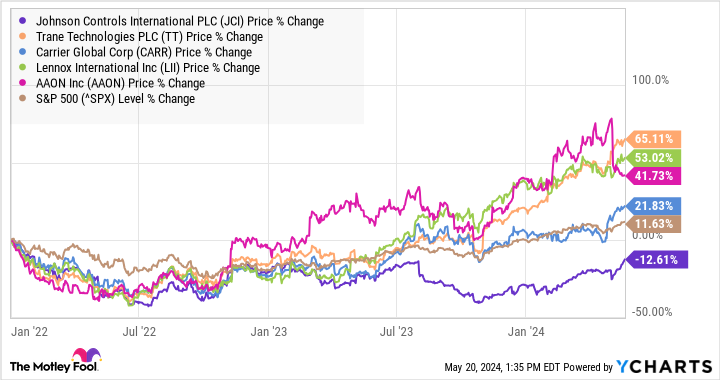The news that high-profile activist hedge fund Elliot Investment Management has built a $1 billion position in building controls and heating, ventilation, and air conditioning (HVAC) company Johnson Controls (NYSE: JCI) has sent the stock higher.
While some of the moves are, no doubt, down to investors who simply looking to jump on the bandwagon, it’s also a reflection that Johnson’s management could do a better job of generating value for investors. Here’s why the latter is a robust case, and the hedge fund move could be a positive catalyst for the stock.
Johnson Controls underperforms
A quick look at the company’s stock chart compared to its HVAC peers and the S&P 500 says a lot. Not only has it significantly underperformed, but it’s down since the start of 2022. It’s been an excellent stock to buy on a dip but not so good for long-term buy-and-hold investors.
It’s surprising because the company operates in desirable end markets. Its solutions help building owners meet their net zero emissions targets by improving building efficiency. This applies to new buildings and also to the retrofitting of existing buildings. Net zero targets drive demand for Johnson Controls’ solutions, and its OpenBlue digital platform increases the efficacy of smart building solutions.
Missing guidance
In summary, Johnson Controls management has been over promising and under delivering in recent years, and there are also valid questions about its 2024 guidance.
The table below shows how the company failed to meet its initial 2022 earnings guidance and barely met its 2023 sales growth guidance.
Johnson Controls Initial Guidance vs. End Result | 2022 Initial | 2022 Actual | 2023 Initial | 2023 Actual | 2024 Initial | 2024 Current |
|---|---|---|---|---|---|---|
Organic revenue growth | High-single-digit | 9% | High-single-digit to low double-digit | 8% | Mid-single-digit | Mid-single-digit |
Earnings per share | $3.22-$3.32 | $3.00 | $3.20-$3.60 | $3.50 | $3.65 -$3.80 | $3.60-$3.75 |
Data source: Johnson Controls presentations.
What went wrong?
I’ll get to 2024 in a moment, but first, a brief recap of what happened. Back in 2022, management cut its full-year earnings guidance due to the supply chain crisis that restricted the availability of semiconductor chips and other technology components, negatively impacting some of its higher-margin business. Sales were fine, but margins were not, hence the earnings miss in 2022.
Fast-forward to 2023, and management firmed up its initial full-year organic sales growth guidance to 10% on the second-quarter earnings call. Three months later, on the third-quarter earnings call, management told investors it would be “high-single-digit” growth. The reason? Management put it down to dealers resetting their inventory as product lead times improved. In other words, dealers previously built up inventory when Johnson Controls was struggling to deliver products, but they (dealers) are now running it down as the company is back to delivering products on a normal schedule.
It gets worse; Johnson Controls missed its fourth-quarter 2024 sales and earnings guidance a few months later. As noted at the time, a cyberattack hit the company, which was unfortunate but did not fully account for the sales and earnings miss.
Johnson Controls in 2024
As the table notes, management expects to grow full-year organic revenue in the mid-single-digit range. However, meeting this guidance is no easy task. For example, organic revenue growth declined 1% in the first quarter, was only up 1% in the second quarter, and the guidance is for only a low-single-digit increase in the third quarter.
On the earnings call, Wall Street analysts wanted to know how exactly the company meets its full-year sales growth aspiration in light of three quarters of lackluster growth. Management argued it needed high-single-digit growth in the fourth quarter to make the midpoint of its range and 10% growth to make the high end.
While a cyberattack hit in the fourth quarter of last year, making this year’s comparison easier, it’s still difficult to see how Johnson Controls’ growth can jump so much in the fourth quarter.
As such, the Wall Street earnings per share consensus of $3.58 is below the low end of management’s current guidance.
What it means to investors
Johnson Controls has a lot of upside potential, but its management needs to start delivering on guidance. The pressure is on management to deliver in 2024, and the potential for an activist investor like Elliot to push for change will only grow if the company misses its numbers again. The downside of possibly missing full-year guidance might be limited by the prospect of shareholder activism to enact change. That makes the stock attractive on a risk/reward basis.
So, while investors should be mindful that Johnson Controls might miss, they should also be aware that there’s a good business here and a possible catalyst for change coming if it does so.
Should you invest $1,000 in Johnson Controls International right now?
Before you buy stock in Johnson Controls International, consider this:
The Motley Fool Stock Advisor analyst team just identified what they believe are the 10 best stocks for investors to buy now… and Johnson Controls International wasn’t one of them. The 10 stocks that made the cut could produce monster returns in the coming years.
Consider when Nvidia made this list on April 15, 2005… if you invested $1,000 at the time of our recommendation, you’d have $652,342!*
Stock Advisor provides investors with an easy-to-follow blueprint for success, including guidance on building a portfolio, regular updates from analysts, and two new stock picks each month. The Stock Advisor service has more than quadrupled the return of S&P 500 since 2002*.
See the 10 stocks »
*Stock Advisor returns as of May 13, 2024
Lee Samaha has positions in Trane Technologies Plc. The Motley Fool has positions in and recommends Aaon. The Motley Fool has a disclosure policy.
An Activist Hedge Fund Is Buying This Dividend Stock. Time to Follow? was originally published by The Motley Fool
Credit: Source link




